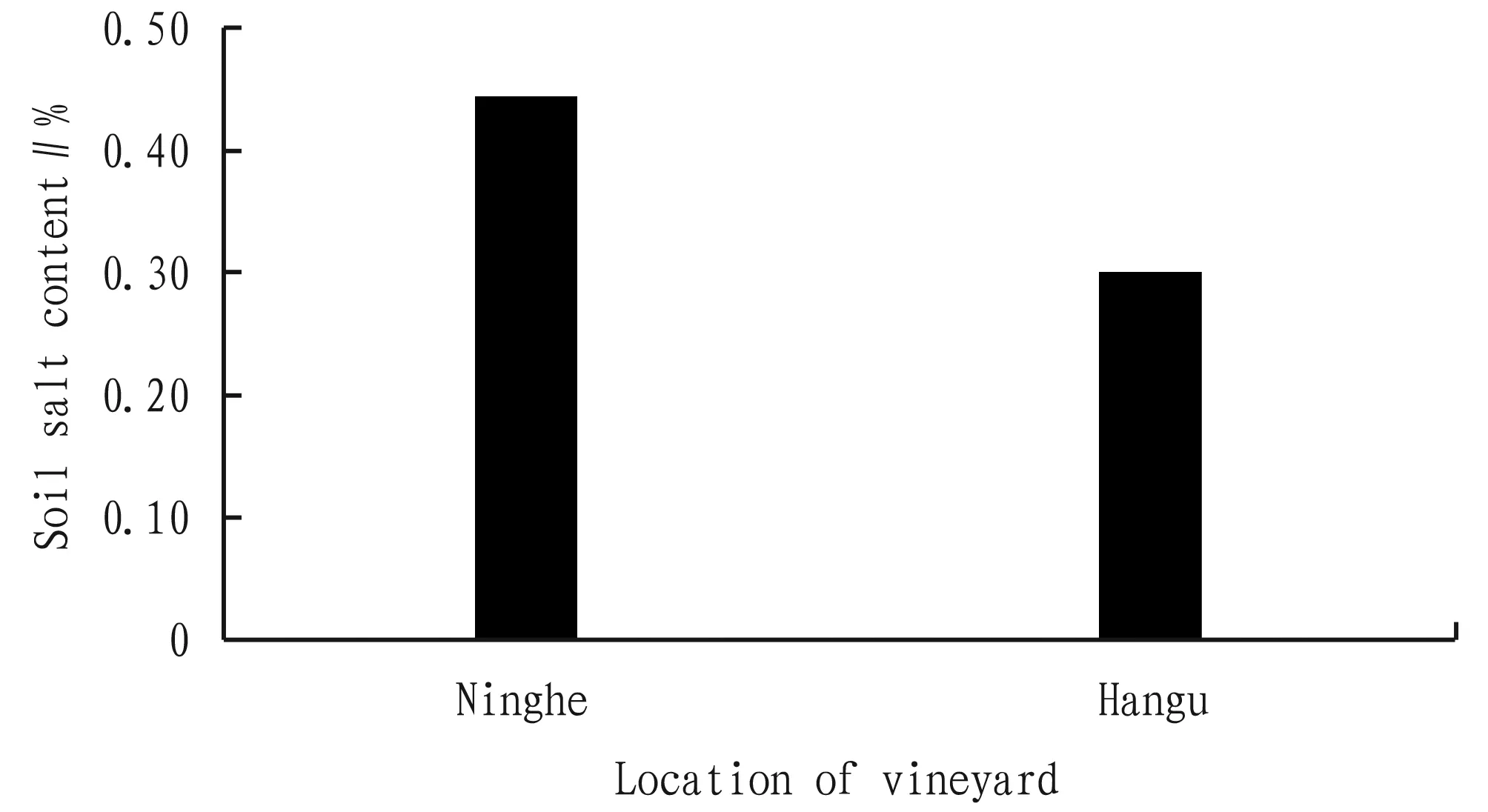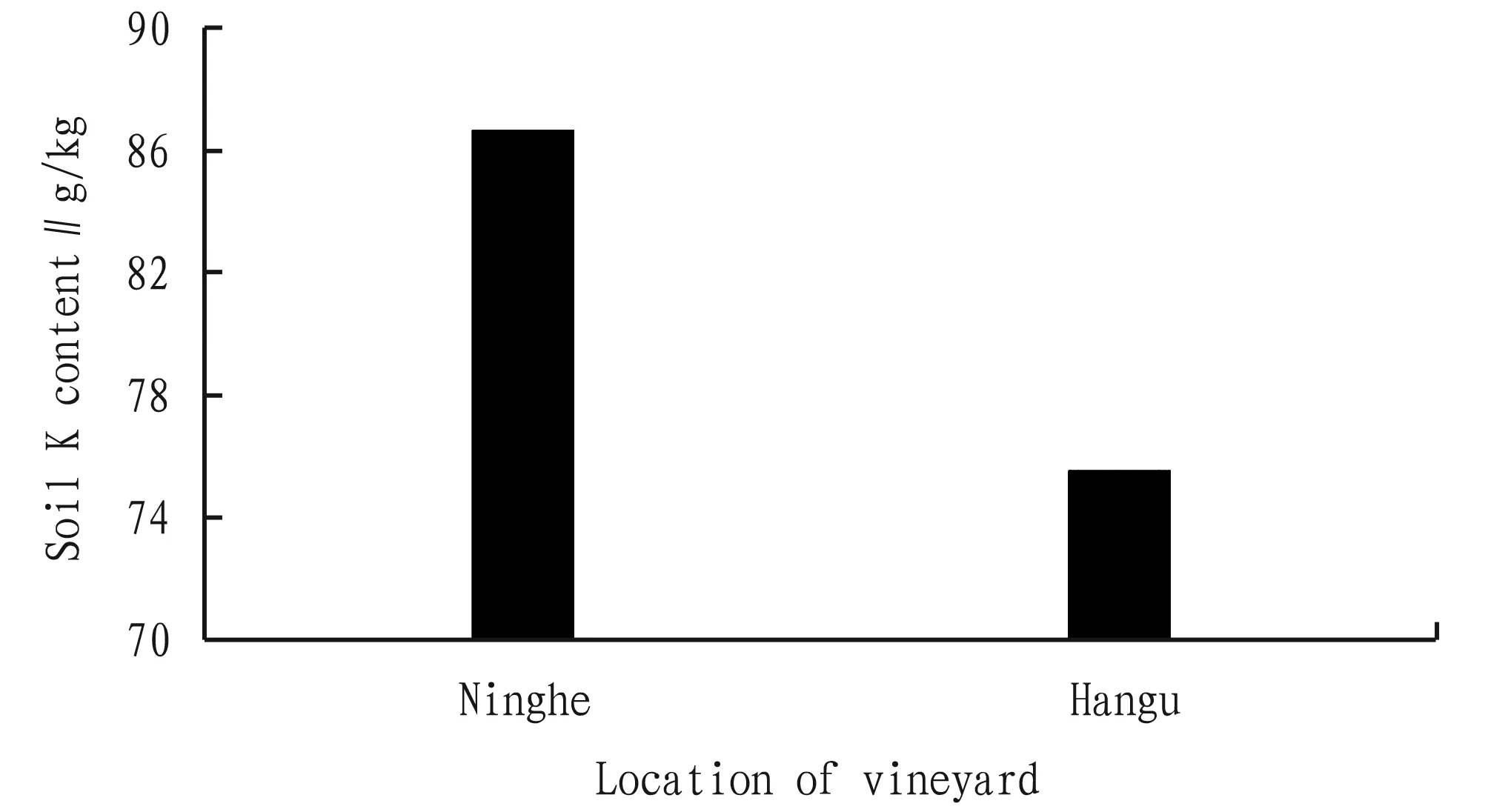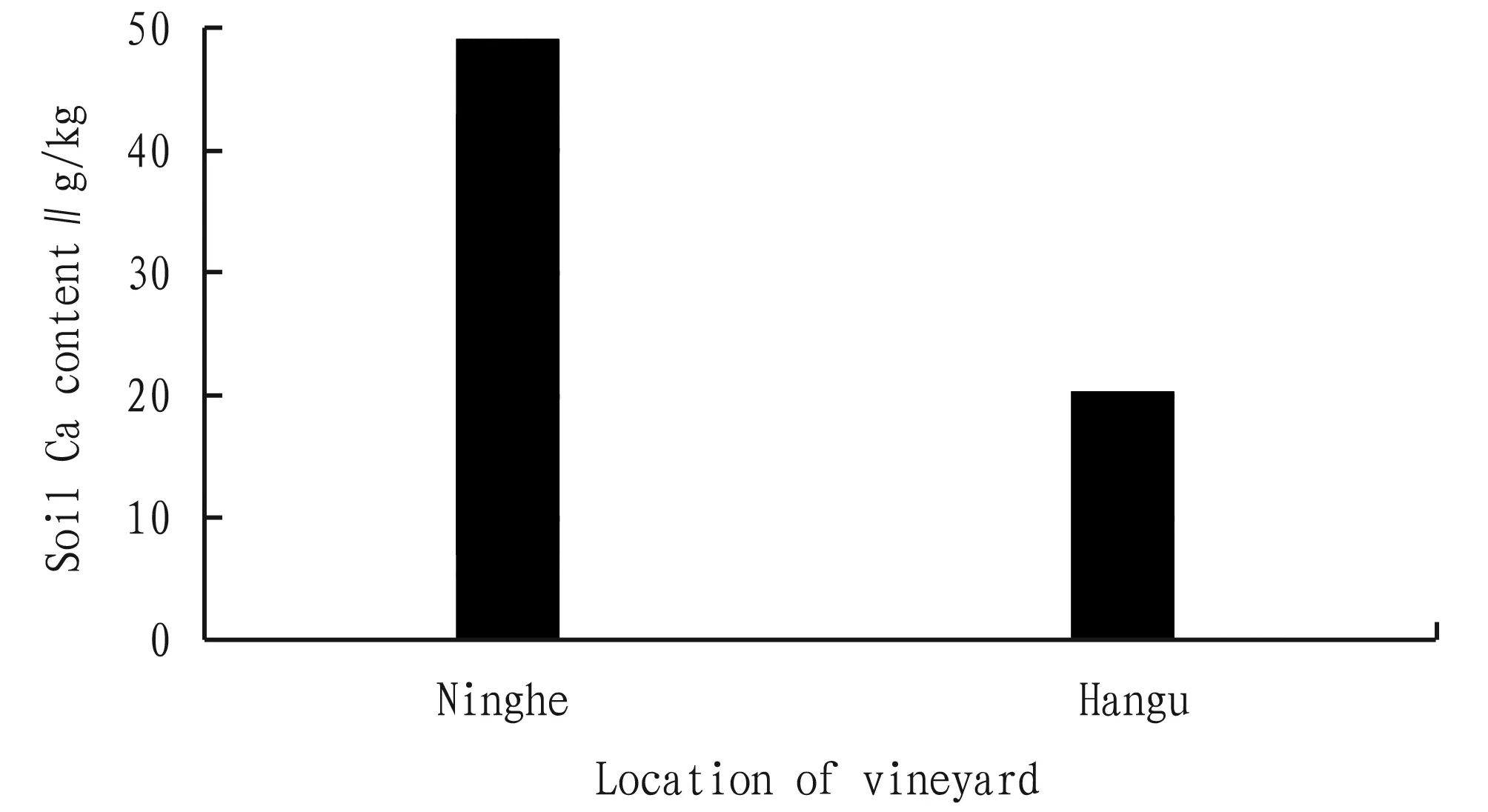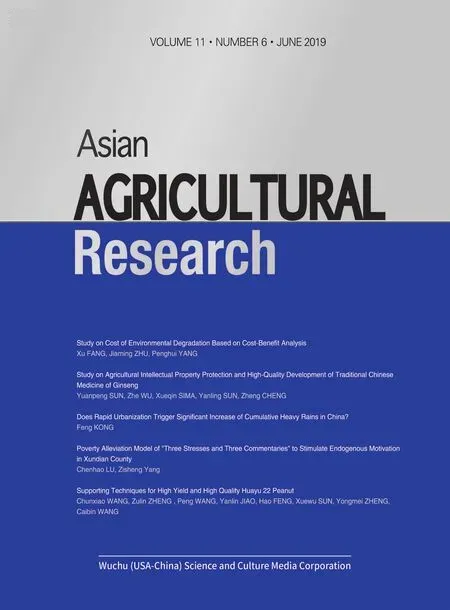Comparison of Soil Nutritional Status between Different Muscat Hamburg Vineyards in Coastal Areas of Tianjin
2019-07-30*
*
1. College of Horticulture and Landscape Architecture, Tianjin Agricultural University, Tianjin 300384, China; 2. Tianjin Institute of Agricultural Resources and Environment, Tianjin 300384, China
AbstractTo study the effects of different soil conditions on winter nutrient storage of Muscat Hamburg branches, this study compared the soil texture, bulk density, total salt content and soil K, Ca, Na, Mg and total Fe contents of Muscat Hamburg vineyards in Ninghe District and Hangu District, Binhai New Area of Tianjin and analyzed the soluble sugar and soluble protein contents in one-year-old vine branches. The results showed that the soil pH was lower, and the soil K, Ca and total salt (0.445%) contents were higher in the vineyard of Ninghe District than those in the vineyard of Hangu District. There were no significant differences in the soil Mg, Fe and Na contents between the vineyards in the two regions. The soil of the vineyard in Ninghe District is medium loam, and that in Hangu District is heavy loam. In short, all the soil indicators of the vineyard in Ninghe District were better than those in Hangu District except the indicator of soil salt content. The soluble sugar and soluble protein contents of one-year-old vine branches differed significantly between the two regions.
Key wordsCoastal areas, Muscat Hamburg, Vineyards, Soil, Nutrient storage
1 Introduction
Grapevine is staple fruit tree with large production area, high yield and numerous varieties, widely cultivated in northern China[1-2]. Muscat Hamburg is an old grape variety, characterized by excellent quality and unique taste, and it is cultivated in the north of China. The Muscat Hamburg grapes growing in Chadian Town, Hangu District, Binhai New Area, Tianjin City are of good quality. The cultivated area of this grape variety is close to 2 000 ha, and it has won the famous brand of "Chadian Meiguixiang" in the national geographical indication[2-7]. Due to long-term cultivation and affected by soil salinity[8-9], the variety has seriously degraded, with reduced yield, degraded quality, serious pest and disease occurrence and poor wintering performance. Rejuvenation of this variety has become the direction of research.
In this study, the soil properties of vineyard and nutrient storage of vine branches of Muscat Hamburg planted in the coastal areas of Tianjin were compared, in order to provide theoretical basis for restoring quality, improving production and obtaining high-quality and high-yield cultivation techniques.
2 Materials and methods
2.1 Vineyard locationThe selected vineyard in Zaojia Village, Zaojiacheng Town, Ninghe District is located in the northeastern part of Tianjin, with an area of 8 ha.
The selected vineyard in Yangjiao Village, Yangjiabo Town, Hangu District, Binhai New Area is located in the eastern part of Tianjin and the western part of Bohai Bay, covering an area of 10 ha.
2.2 MethodsThree pilots, with 667 m2each one, were selected from each vineyard, and five samples were diagonally sampled from each plot. The top soil (0-40 cm) of each sampling point was collected, and the soil samples of each plot were mixed and then sampled by the quartering method.
Soil texture was determined by the wet test method. The soil samples were smashed into balls, strips, sheets and rings, divided into different textures. Soil pH was measured using a pH meter. Soil bulk density was determined by the cutting ring method. Soil water soluble salt content was determined by the drying method. The contents of soil metal ions were measured by a PinAAcle 900T atomic absorption spectrophotometer manufactured by PE Company, USA.
Soluble protein content of vine branches was determined by Coomassie brilliant blue G-250 staining, and soluble sugar content was determined by anthrone colorimetry. The experimental data were processed using Excel and subjected to difference significance test using SPSS 22.0.
3 Results and analysis
3.1 Comparison of soil textureTable 1 shows that the soil of the two Muscat Hamburg vineyards in Ninghe and Hangu was both loam, but the stickness was different. The soil in the vineyard in Ninghe was medium loam, and that in the vineyard in Hangu was heavy loam. According to literature, grapevine prefers sandy loam or loam, so the soil texture of the vineyard in Ninghe is more suitable for grape growth.
Table 1 Comparison of soil texture between Muscat Hamburg vineyards in Ninghe and Hangu

Location of vineyardSoil texture characteristicsSoil texture categoryNingheSoil could be made into ball, and it did not scatter when held in hand; soil did not fragment when smashed into 3-mm-thick strip; and soil broke when the soil strip was bent into a small circle with a diameter of 2-3 cmMedium loamHanguSoil could be smashed into stripe and bent into circle, and it cracked when pressing the circleHeavy loam
3.2 Comparison of soil pHAs shown in Fig.1, the soil pH of the Ninghe and Hangu vineyards were both greater than 7, which was alkaline soil. The soil pH of the vineyard in Ninghe was 7.9, and that in Hangu was 8.2. The vineyard soil in Ninghe was less alkaline than that in Hangu.

Fig.1 Comparison of soil pH between Muscat Hamburg vineyards in Ninghe and Hangu
3.3 Comparison of total salt content in soilAs shown in Fig.2, the total salt content in the vineyard soil of Ninghe was 0.445%, and that in the vineyard soil of Hangu was 0.301%. The result of significance difference test shows that there was significant difference between the two.

Fig.2 Comparison of soil salt content between Muscat Hamburg vineyards in Ninghe and Hangu
3.4 Comparison of soil metal ion contents
3.4.1Comparison of soil K content. As shown in Fig.3, the K content in the vineyard soil of Ninghe was 86.72 mg/kg, and that in the vineyard soil of Hangu was 75.58 mg/kg. The result of difference significance test shows that the vineyard soil K content in Ninghe was significantly higher than that in Hangu.
3.4.2Comparison of soil Mg, Fe and Na contents. In the vineyards of Ninghe and Hangu, the soil Mg content ranged from 60 to 78 mg/kg, the soil Fe content ranged from 155 to 167 mg/kg, and the soil Na content was in the range of 47-53 mg/kg. The vineyard soil Mg, Fe and Na contents differed insignificantly between the two regions.

Fig.3 Comparison of soil K content between Muscat Hamburg vineyards in Ninghe and Hangu
3.4.3Comparison of soil Ca content. As shown in Fig.4, the vineyard soil Ca content of Ninghe was 49.11 mg/kg, and that of Hangu was 20.36 mg/kg. The result of difference significance test shows that the vineyard soil Ca content of Ninghe was significantly higher than that of Hangu.

Fig.4 Comparison of soil Ca content between Muscat Hamburg vineyards in Ninghe and Hangu
3.5 Comparison of soluble protein content in vine branches
As shown in Fig.5, the soluble protein content in the vine branches of Ninghe was 0.25 mg/g, and that in the vine branches of Hangu was 0.20 mg/g. The result of difference significance test shows that the soluble sugar content in the vine branches of Ninghe was significantly higher than that of Hangu.
3.6 Comparison of soluble sugar content in vine branchesAs shown in Fig.6, the soluble sugar content in the vine branches of Ninghe was 0.73 mg/g, and that in the vine branches of Hangu was 0.87 mg/g, The result of difference significance test shows that the soluble sugar content in the vine branches of Ninghe was significantly lower than that of Hangu.

Fig.5 Comparison of soluble protein content in Muscat Hamburg vine branches between Ninghe and Hangu

Fig.6 Comparison of soluble sugar content in Muscat Hamburg vine branches between Ninghe and Hangu
4 Conclusions and discussions
The soil in the vineyard of Ninghe was medium loam, with pH value of 7.9, total salt content of 0.445%, K content of 86.72 mg/kg and Ca content of 49.11 mg/kg. The soil in the vineyard of Hangu was heavy loam, with pH value of 8.2, total salt content of 0.301%, K content of 75.58 mg/kg and Ca content of 20.36 mg/kg. It shows that the soil texture of Ninghe vineyard was better, with slightly lower pH value, higher nutrient contents, and higher total salt content. The soluble protein content in the one-year-old vine branches of Ninghe was higher, and the soluble sugar content was lower.
Overall, the soil indicators of Ninghe vineyard were better. In terms of nutritional status of the branches, the soluble protein content in the vine branches of Ninghe was higher. It shows that the growth conditions of Muscat Hamburg in Ninghe were better than those of Chadian, Hangu. In the future, the yield and quality of Muscat Hamburg can be further analyzed to promote grape production in Ninghe District.
杂志排行
Asian Agricultural Research的其它文章
- Personnel Cultivation Program for Innovative and Entrepreneurial Biopharmaceutical Discipline under the Credit System
- Screening and Analysis of Cadmium-tolerant Rice Variety Resources
- Supporting Techniques for High Yield and High Quality Huayu 22 Peanut
- Drought Tolerance Identification and Eevluation of Maize during Flowering Stage in Guangxi
- The Model of "Party Branch+" in Promoting Industrial Poverty Alleviation in Poverty-stricken Mountainous Areas of China: A Case Study of Xundian in Yunnan Province
- Industrial Poverty Alleviation Model in Deep Poverty-stricken Villages in the Dry-hot Valley of Jinsha River: A Case Study of Poverty Alleviation in the Green Prickleyash Planting Industry in Laopingzi Village, Luquan County
